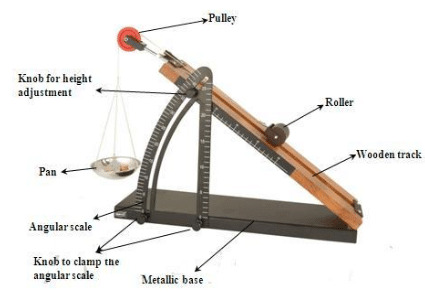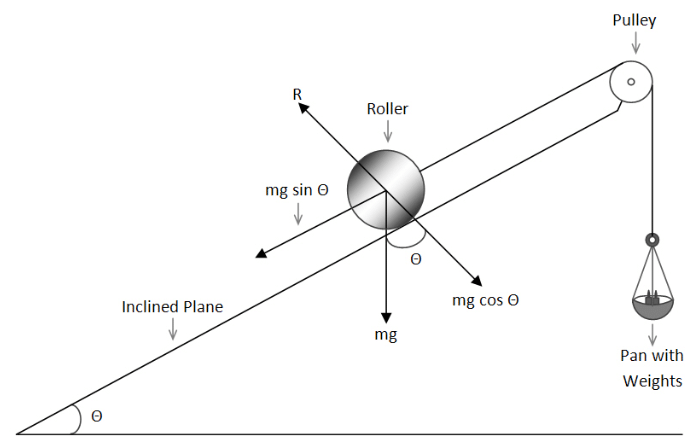Theory & Procedure, Inclined Plane | Additional Study Material for NEET PDF Download
Objective:
- To find the downward force along an inclined plane, acting on a roller due to the gravitational pull of the earth.
- To study its relationship with the angle of inclination θ by plotting a graph between applied force and sin θ.
Theory:
The inclined plane consists of a smooth plane hinged to a base so that it can be set at any desired angle. Consider a heavy metal roller connected to a scale pan by a light extensible string passing over a frictionless pulley resting on the plane as shown in the figure given below.

If a body of mass (say m) is placed over an inclined plane, that is inclined at an angle θ with the horizontal, its weight mg acts vertically downward. The component mg cos θ of the weight acts normally downward on the plane balances the upward normal reaction (say R) of the inclined plane. The component mg sin θ of the weight acting parallel to the inclined plane downwards, produces motion in the body. If total weight W1=m1g moves the body up and total weight W2 = m2g makes the body move down,
If total weight W1=m1g moves the body up and total weight W2 = m2g makes the body move down,
Then the downward force acting on the body along the inclined plane,
 which must be equal to
which must be equal to
Thus, a graph between sin θ along X-axis and W along Y-axis must be a straight line.
Learning Outcomes:
- Students understand the working of an inclined plane.
- Students understand idea of normal reaction and downward force acting on an inclined plane.
Materials Required:
- An inclined plane with a pulley
- A roller
- A pan
- A weight box
- Spring balance
- Spirit level
- Strong thread
- Half meter scale.
Simulator Procedure (as performed through the Online Labs)
- Choose an appropriate environment from the combo box to perform the experiment.
- Select a desired angle from the slider, “Angle”.
- Increase the loading weights using the slider, “Hanging weight”.
- Note the total weights added when the roller just starts moving upward with uniform velocity.
- Decrease weights little by little using the same slider and note down the total weights when the roller just starts rolling down with uniform velocity.
- To measure the height and length of the inclined plane, click on the button, “Show Scale”.
- A reset button is provided to reset the entire experiment anytime.
Real Lab Procedure:
- Place the apparatus on a table. Make sure that the base of the inclined plane is at horizontal surface.
- Bring the inclined plane to a horizontal position so that the angle of inclination is now zero.
- Find the weight of the roller, m using the spring balance. Then, place it on the inclined plane in the middle.
- Tie one end of a thread to the roller placed on the inclined plane and pass it over the pulley.
- Find the mass of the pan using a beam balance and tie it to the free end of the thread.
- Now, raise the inclined plane and fix it at an angle of 30°. When this is done, the roller starts rolling down with acceleration.
- Add weights and increase them till the roller just starts moving upward with uniform velocity only on tapping. Note the mass added in the pan and calculate the total mass m1 as sum of mass added in pan and mass of the pan .
- Remove some weights from the pan till the roller just starts moving downward with uniform velocity. Note down the mass added in the pan and find the total mass m2 as the sum of mass added in pan and mass of the pan .
- The mean value of m1 and m2 multiplied with acceleration due to gravity, g gives the downward force, W acting on the roller of mass m.
- It is proved that, in each case, the downward force acting on the body, W is found to be equal to mg sin θ.
- A graph is drawn with sin θ along X-axis and W along Y-axis and it is a straight line.
- Increase the angle of inclination in steps of 5° each, making it 35°,40°, 45°, 50°,55° and 60° and repeat steps 6 to 8.
- Record the observations
|
26 videos|312 docs|64 tests
|
FAQs on Theory & Procedure, Inclined Plane - Additional Study Material for NEET
| 1. What is an inclined plane? |  |
| 2. How does an inclined plane work? |  |
| 3. What are some real-life examples of inclined planes? |  |
| 4. How can the mechanical advantage of an inclined plane be calculated? |  |
| 5. What are some advantages of using inclined planes? |  |






















